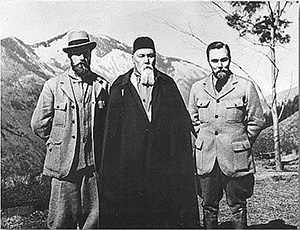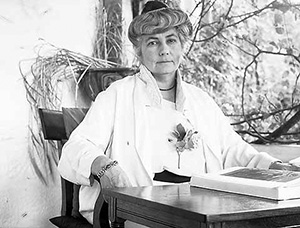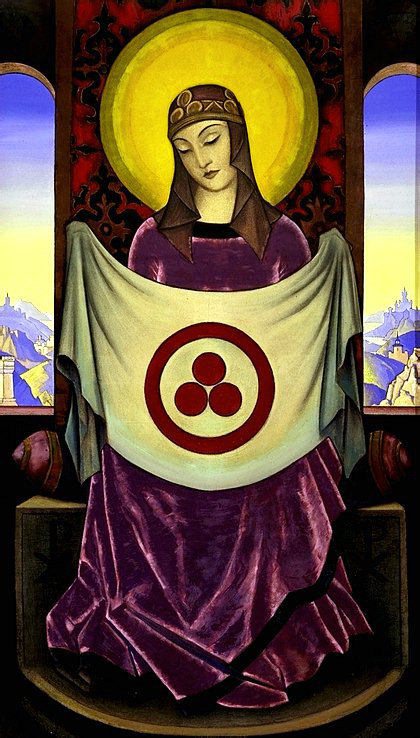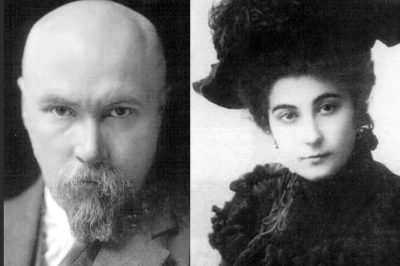This article was published in New Dawn 99 (Nov-Dec 2006)
Visionaries, luminaries, and spiritual pioneers Nicholas and Helena Roerich were two of Russia’s most outstanding people. High initiates, they devoted their lives to helping the advancement of humanity. And as is often the way with many great spiritual leaders, their path was liberally strewn with hardship and adversity: revolutions, captivity, spy charges, deception and deceit; testing the Roerichs constantly on their shared belief that it was these very obstacles that would allow them to grow.
Yet, despite the fact that the couple were once barred from entering the United States and their teachings prevented from circulating freely throughout Russia, the Roerichs’ ideas are today reaching an ever-expanding group of people around the world.
Perhaps it is an attempt to bring balance and harmony to our world of unrest, pain and strife that is causing the massive desire to know more of Nicholas, the painter and mystic, and his wife Helena, the co-author of the Agni Yoga series of metaphysics and deep spirituality.
Internationally acclaimed artist, author, explorer, archaeologist, humanitarian, conservationist and peacemaker Nicholas Konstantinovich Roerich (1847–1947) was born in St. Petersburg, Russia. He met his beloved wife and life partner Helena Ivanovna (1879–1955) on his way to excavate in the eastern part of Russia, and they married in 1901.
She was a gifted musician and healer who had been studying the ancient spiritual writings of India and the East for years; in time, she became an inspired writer and teacher. He eagerly shared her pursuits for wisdom and knowledge. Together, they explored the teachings of Rama Krishna, the Buddha and also studied Madame Helena Blavatsky’s writings and philosophies. Once safely out of Russia and the civil war that raged following the 1917 Russian Revolution, they used their time in exile to test and experiment with the Theosophical teachings. It was at this time that they met Master Morya, their spiritual teacher. Since her childhood, the Masters (members of the Brotherhood of Light) had been working with Helena in her dream world but now the work took an additional form as page after page of expansive, astonishing information was dictated to them.
After leaving Russia, the Roerichs and their two sons had first gone to Scandinavia, then made their way to England, eventually arriving on the shores of America. But the United States was not their ultimate destination. Their actual goal was India. For some years after 1917, India – the Raj – was closely maintained by the British who were constantly on guard against infiltration by Russian Bolsheviks bringing their inflammatory thoughts of revolution. The Roerichs were clearly on the list of those not wanted. In time, the way did open for them to enter India and although they never knew it, they were continually kept under surveillance. This fact accounts for many of their hardships.

The Roerich family arrived in New York City in the fall of 1920. Within the next three years they had gathered about them a little circle of the perfect people to accomplish all of their goals: the formation of an idealistic artist’s society called Cor Ardens, to encourage artists to push themselves to greater heights of artistic ability; the Master School of United Arts where all of the arts where taught under one roof and students were encouraged to express themselves in various media – thereby giving them the opportunity to become more rounded individuals. And Corona Mundi, an international art museum, founded to display artistic treasures from Central Asia and other areas of the world. Roerich’s paintings were exhibited in 26 US states and he and Helena toured much of the country – meeting and exchanging ideas with the most open-minded, progressive people in the arts and humanities.
Central Asian Expeditions
In 1924, they left New York for Europe which was the last stop before going to India and beginning their four-year Central Asian expedition. The history of Central Asia of the late 1800s and early 1900s is sprinkled with daunting accounts of fearless explorers and adventurers; men and women such as Helena Blavatsky, Alexandra David-Neel, Sir Aurel Stein, Sven Hedin, and Russian born Col. Nikolai Przhevalsky, who discovered a breed of horse that was named in his honour. But none of those were artists and to the best of my knowledge, none were on a mission to Shambhala. The couple were both past fifty years old when they undertook the gruelling journey to traverse Central Asia for four years on foot, camel, horse and yak enduring the brutal heat of the lowest desert elevations and laboring over the highest mountains ranges on the planet.
What is it that stirs people to leave the comfort of their home and set off for the unknown? Gold? Religious freedom? The quest for a better life? For the Roerichs, the reasons were many. Nicholas was interested in proving the migration routes of the early tribes that encircled the globe. He wanted to be the first Westerner to paint and document the vast mountain ranges of India, Tibet and Central Asia and search for and uncover treasures long-hidden by the desert sands.
Through fourteen years of researching, thinking and writing about the Roerichs, I could not help but question the real purpose of the Roerichs’ Central Asian expedition. Unbeknownst to me, a Russian scholar by the name of Vladimir Rosov, was quietly helping. Just as I had began my work by living a short time in India and meeting with Svetoslav Roerich, reading through Madame Roerich’s journals and some personal correspondence, searching through the files kept in the Library of Congress and the Freedom of Information Act; researching old micro-fiche, newspapers, and the British Secret Files for facts regarding the Roerichs’ years in America, Rosov had been studying and sifting through all the Roerich documents which had been unavailable to researchers before Gorbachev’s Perestroika restructured the country. The results of his work can be read (in Russian) in his two volumes, whose name in English translates to Nicholas Roerich, The Messenger of Zvenigorod.
In the first volume, he relates a startling story which answered all my questions and astonished the world of Roerich followers. Since it was already in print, I was able to use it, thereby becoming the first person to tell (in English) the real story of the Roerichs’ four-year expedition. Rosov’s account also provided a new basis for understanding the Roerich’s second trip – during which the United States sent Roerich and his son George, back to Central Asia in search of drought resistant grasses to help prevent a reoccurrence of the disastrous “dust bowl” of 1934. It was this expedition which broke Roerichs’ friendship with Henry A. Wallace, US Secretary of Agriculture during Franklin D. Roosevelt’s administration, and led to Roerich being barred from returning to the United States.
Shambhala
For years various authors have written about Shambhala. Though many people are familiar with the term, a far greater number of people have no idea what it refers to. Those “in the know” think that the search for Shambhala was the purpose of the Roerichs’ four year expedition. And they are both right – and wrong.
Shambhala is a Sanskrit word meaning “place of peace, tranquillity and happiness.” It is considered a mystical place – both visible and invisible – where the higher world connects with the realm of Earth. The earliest references to Shambhala are found in the more than three hundred volumes of Kanjur and Tangyur, the most sacred books of Tibetan Buddhism. The books say it is a hidden kingdom, located somewhere north of Bodh Gaya, the Buddhist shrine in northern India. Shambhala is thought to be an oasis, completely ringed by high, snowy mountains that glisten with ice. Some lamas were said to hold the opinion that it has peaks which are perpetually hidden in the mists, while others believe it is visible but too remote for anyone to get close enough to see. And then there are the stories of people who tried to find Shambhala and were never seen nor heard of again.
Many Tibetans were said to regard Shambhala as a heaven of the gods or a special paradise, meant only for those on their way to Nirvana. Possibly the Roerichs first heard the term while reading one of Madame Blavatsky’s books on Theosophy or if not then, it might have been in 1912 when a famous Buddhist lama was in St. Petersburg helping with the construction of a Buddhist temple. However, when the lama spoke of it, he was not speaking of a destination; he was speaking of a famous Buddhist prophecy.
The prophecy involved the Panchen Lama, who held a position the Dalai Lama had created several hundred years earlier in order to share the leadership of Tibet. The Dalai Lama was the temporal leader of the country and the Panchen Lama was the spiritual leader. The prophecy predicted that one day the Panchen Lama would leave Tibet. Once this happened, a great army would arise to destroy the forces of evil and usher in a golden age, a thousand years of peace and harmony. In order for that to occur, however, the Panchen Lama would have to die. When he was reborn, he would be named Rigden Jypo and be the Maitreya, The Coming One, the king of Shambhala, the abode of the mystical Buddhist learning and the symbol of the Great Future. Shambhala was the guiding principle of the coming Kalpa, or cosmic age, and at the sound of that powerful name, certainly something awoke in the Roerichs’ hearts as it does in the hearts of all people who yearn for peace.
However, when the Roerichs’ spiritual teacher, Master Morya, spoke of Shambhala, he gave the name an additional meaning for it was how he referred to the new country that he wanted the Roerichs to create. Morya envisioned a new Buddhist spiritual country to be established on the borders of Mongolia, the Gobi and Siberia. This country was to be governed jointly by the Panchen Lama and Roerich.
Therefore, the two major purposes for the expedition – which were kept private and confidential – were so that the Roerichs could prepare the ground for the new country and the commerce necessary for it to be financially sound; and to find the Panchen Lama so that they could parlay with him, present this startling (and naive) idea, and convince him it was possible and viable. Considering, however, that all of the land involved was already occupied and within the boundaries and domain of other governments, the fulfilment of this plan was highly improbable. One country attempting to take land from another is what wars have been fought about throughout time. When the first expedition was aborted after the Tibetans (and British) kept the Roerich Central Asian expedition freezing in captivity for four months on the border of Tibet and then sent them straight back to India, it looked as if all plans were foiled.
Then, Henry A. Wallace offered Roerich a second chance and sent him back to Central Asia. But, with China and Japan on the brink of war, it was a very dangerous and volatile time. This trip Helena Roerich stayed behind and Nicholas, an artist – not a diplomat, blundered about until Wallace ordered him to return to India and stay there – and not leave again.1 Years later, looking back on the entire event, Madame Roerich wrote in her journal that both the Panchen Lama and her husband were too old at the time to accomplish this feat. Perhaps the Roerichs were laying down the lines of light necessary for it to become a reality in the future.

Considering that during the entire four year expedition Roerich’s travel plans were continually thwarted by visa and passport difficulties, it is surprising that Nicholas and Helena even attempted to accomplish the establishment of a new country. To me it seems a demonstration of their loyalty and dedication to work with their teacher.
Art, Beauty and Unity
Roerich loved the concept of unity. He believed that “beauty is the force that can bring nations together.” He hated borders and boundaries and thought that since all the people of the world belonged to one family, they should be able to roam and travel freely throughout it.
Nicholas and Helena Roerich had very expanded consciousnesses. They believed “that knowledge and beauty are the real cornerstones of evolution, the gates to a world community.” They taught that a synthesis of knowledge from all fields of human endeavours was needed to form a fully developed being. Nicholas wrote nearly thirty books and created over 7,000 paintings and theatre designs depicting scenes from ancient Slavic myths, the Himalayan Mountains, and spiritual themes from the world’s religions.
People who see his art for the first time are often speechless at the inspirational use of colour and the spiritual power it evokes – especially his later work, completed during and after the four years of expedition. Roerich’s paintings portray spiritual development, culture and its role in human evolution and possibilities for peace in a troubled world. A broader and more metaphysical understanding is added to the paintings once the viewer penetrates Helena’s deeply spiritual writings. In addition to the Agni Yoga series, which she wrote in conjunction with Master Morya, she wrote On Eastern Crossroads under the name of Josephine Saint-Hilaire.
Daring explorers, the couple investigated the remote and dangerous regions of China, Mongolia and the Gobi Desert where few Westerners had previous ventured. They were seeking ancient manuscripts hidden in subterranean crypts and caves, the treasures to be found in burial mounds, and the wealth of statues, artifacts and wall paintings left behind in caves by the artistic Buddhists.
In 1929 Nicholas Roerich was nominated for the Nobel Peace Prize for his work in creating the Banner of Peace and the Roerich Peace Pact, designed to preserve the world’s treasures from being destroyed in time of war. Franklin Roosevelt and twenty-six world leaders met in Washington, D.C. to ratify the agreement. The Roerichs were friends and advisors to heads of state, scientists, artists, writers and poets. Roerich’s work won praise from Albert Einstein, Leo Tolstoy, George Bernard Shaw, Jawaharlal Nehru, Rabindranath Tagore, and many others.

Now, over fifty years later, many of their key ideas have found a place in the human soul: the equality of the feminine and the masculine principles, the wisdom of the heart and the striving for the common good and brotherhood. The eternal truths the Roerichs demonstrated on Earth are echoing through time, awakening humanity to beauty and unity. “Beneath the sign of beauty we will walk joyfully,” wrote Nicholas Roerich. “With beauty we conquer. Through beauty we pray. In beauty we are united.”
To the Roerichs, culture was the highest expression of the Light – the “cult” of Ur (Light). They considered that beauty and art speak an international language understood by all and that focusing on the beautiful in life would lead us to world peace.
Nicholas Roerich wrote:
If you shall be asked, of what kind of country and of what constitution you dream, you can answer in full dignity: the country of Great Culture. You shall know that in that country peace and knowledge and beauty will be revered…. You may say: life is hard. How can I think of knowledge and beauty if we have nothing to live on? Or: We are far away from knowledge and art; we have important business to attend to first. But I say: You are right, but you are wrong. Knowledge and art are not luxuries. Knowledge and art are not idleness. They are the prayer and work of the spirit. Men pray in the moments of great difficulty. So too, is this prayer of the spirit most needful, when one’s whole being is shaken and in want of support, and when it seeks a wise solution.
An arduous trial awaits the whole world: the trial by the assimilation of truth. After the medieval trials by fire, water and iron, now comes the trial by assimilation of truth. But if the power of the spirit upheld men against fire and iron, then will that same power not also raise them up the steps of knowledge and Beauty?
Throughout the world, in Israel, India, Mexico, Germany and many other countries, schools, civic organisations, and ordinary citizens are flying the Banner of Peace, proclaiming Peace through Culture. Do you want to join in this effort? If each person who reads this article would take the time to research, create, and fly the Banner of Peace – a white flag with three magenta balls in the middle – over their home, place of business, he or she will be contributing to the cause of Peace.
Let’s all do it now! Dedicate ourselves to the cause of peace and align ourselves with the hundreds and thousands of people around the world who are using Nicholas and Helena Roerichs’ legacy and memory for inspiration.
Please visit www.roerich.org to see Roerich’s wonderful paintings and learn more of this fascinating couple.
Footnote
1. For the full and complete account of this event, see my book Nicholas & Helena Roerich, The Spiritual Journey of Two Great Artists and Peacemakers.
© New Dawn Magazine and the respective author.
For our reproduction notice, click here.


